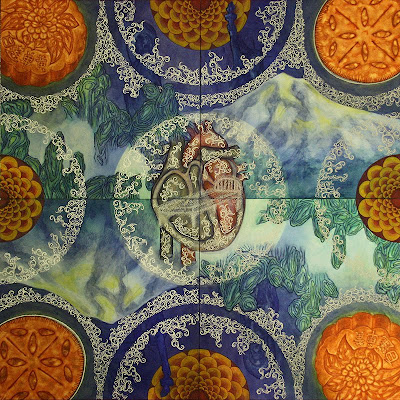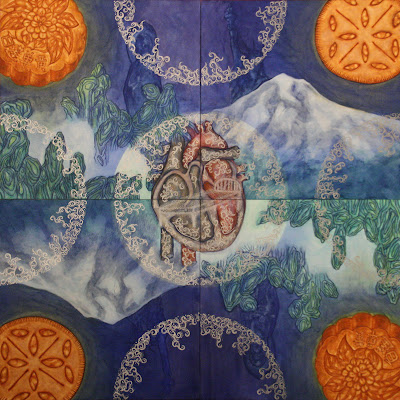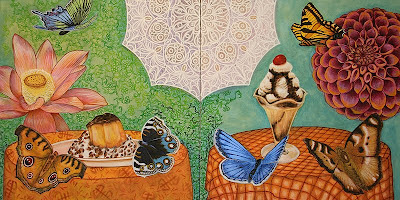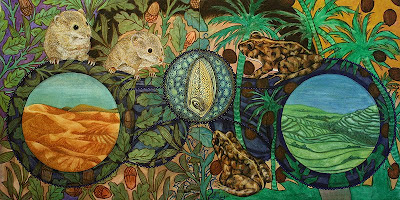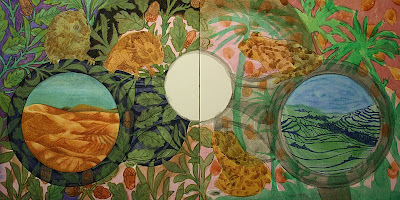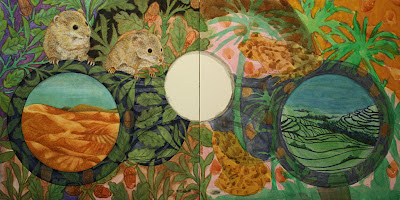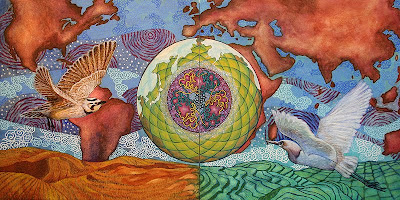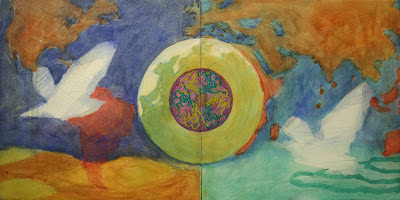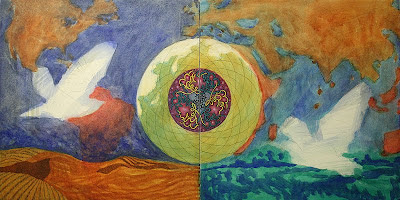
Supercal...alidocious
Diptych
Gouache and acrylic on paper mounted on birch panels
12" H x 24" W
2012
The 9th from the series Red Bean Paste and Apple Pie.
There's a Chinese saying, "choose either fish or bear paws, but you can not have both." Although I've never had to choose between a fish and a bear paw (and really, who has!?), I think having to choose between locally grown cherries and locally grown lychees might prove to be fairly impossible.
Food brings a sense of place both in the locations where they are grown, but also in our imagination. Growing up in Taiwan, cherries were associated with a romanticized version of the West, a symbol of luxury and elegant living. I remember the imported chocolates with the cherries and syrup buried within, the contents gooey and indecipherable. I remember a commercial where a beautiful woman leisurely bathed in a huge tub of bubbles (another symbol of Western luxury), and a bowl of fresh cherries sat on the edge of the tub. It wasn't until I moved to Oregon, started working and shopping for myself that I first encountered a fresh, real life, locally grown cherry.
It's no coincidence that around the first time I encountered my first real cherry was also about the last time I had a fresh, locally grown, delicious lychee. The summer of 1983. Yup, that's how long it's been. I have not been back to Taiwan during lychee season ever since. Lychee needs those hot, hot tropical summers to ripen and they have a very short season. And that season happens to be around the same time that cherries ripen here.
So there you have it, choose either lychees or cherries, but you can not have both. (Admittedly, the heat and the humidity in the tropical summer is one of the reasons why I have not gone to Taiwan during lychee season, but, for artistic reasons, we will not talk about that.)
Here's how the piece started, a 5-petal cherry blossom, and some ovals that I was planing to develop into some lychees:

I'm sketching in a view of the Columbia River Gorge around Hood River, famous for its cherry orchards and high winds (and coincidentally, the 1st essential factor for growing lychees is "no wind"... I'm not making this up, you really can't have both):

I decided that I really didn't care for the oval shapes around the petal shapes (too many similar shapes?), so I decided to go for a moon in the night sky instead; and the hills of the gorge are going in:

Started in on the tropical hills:

Cherries and lychees are magical, and the tropical forest is filled with ferns:

The lychees are mostly there, and the cherries are going in:

At this point, I had quite a bit of trouble finishing this piece. I tried several things, didn't care for them and had to take them out. I finally put in the high clouds and more cherry leaves, but then thought I didn't like those either. I sat on it for two days, staring at the photograph on the computer constantly (that's often how I review work), and finally decided that the high clouds had to go. I went into my studio tonight to take them out, saw the piece in real life and thought, "wait, I like it like this!"
In the end, the clouds stayed, but the fog/mist in the tropical forest got a bit more mellow, and I'm happy. The finished piece is the first image at the top.

